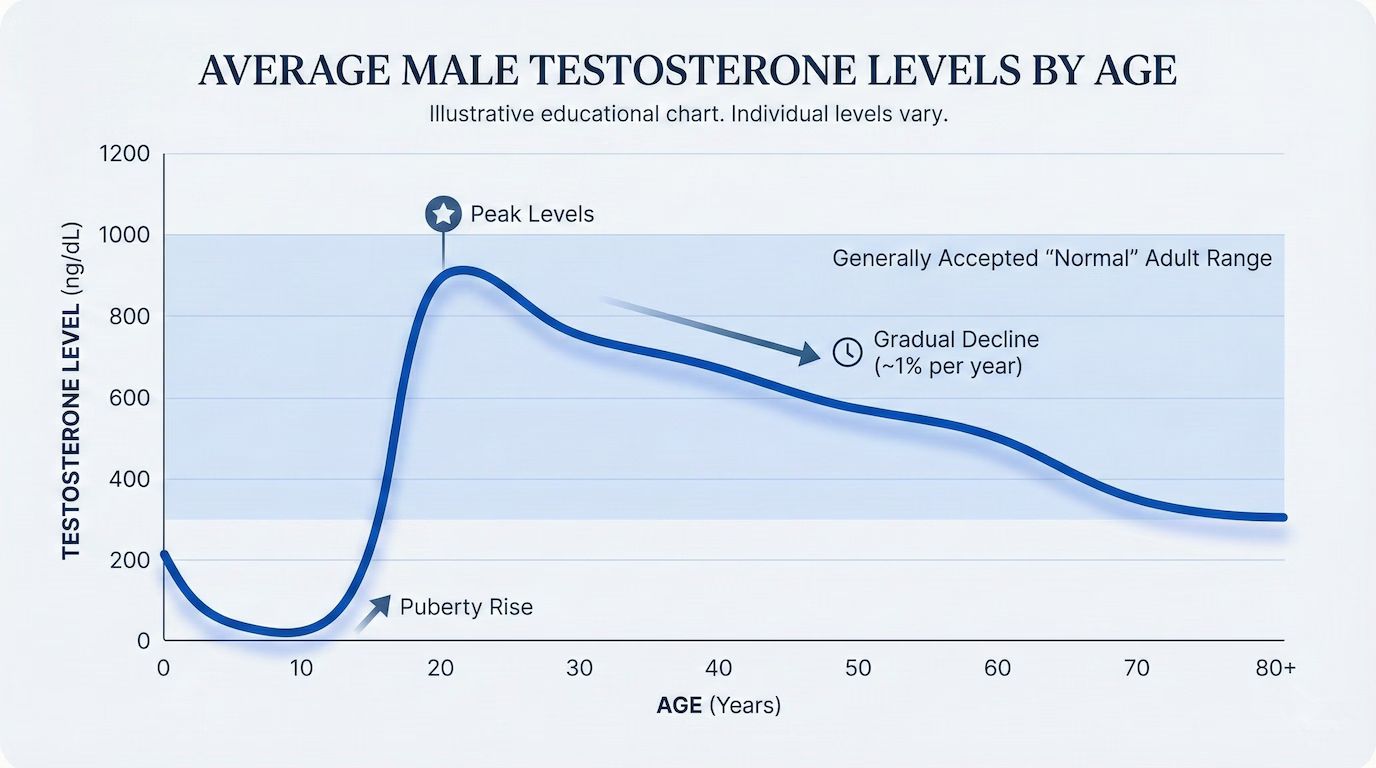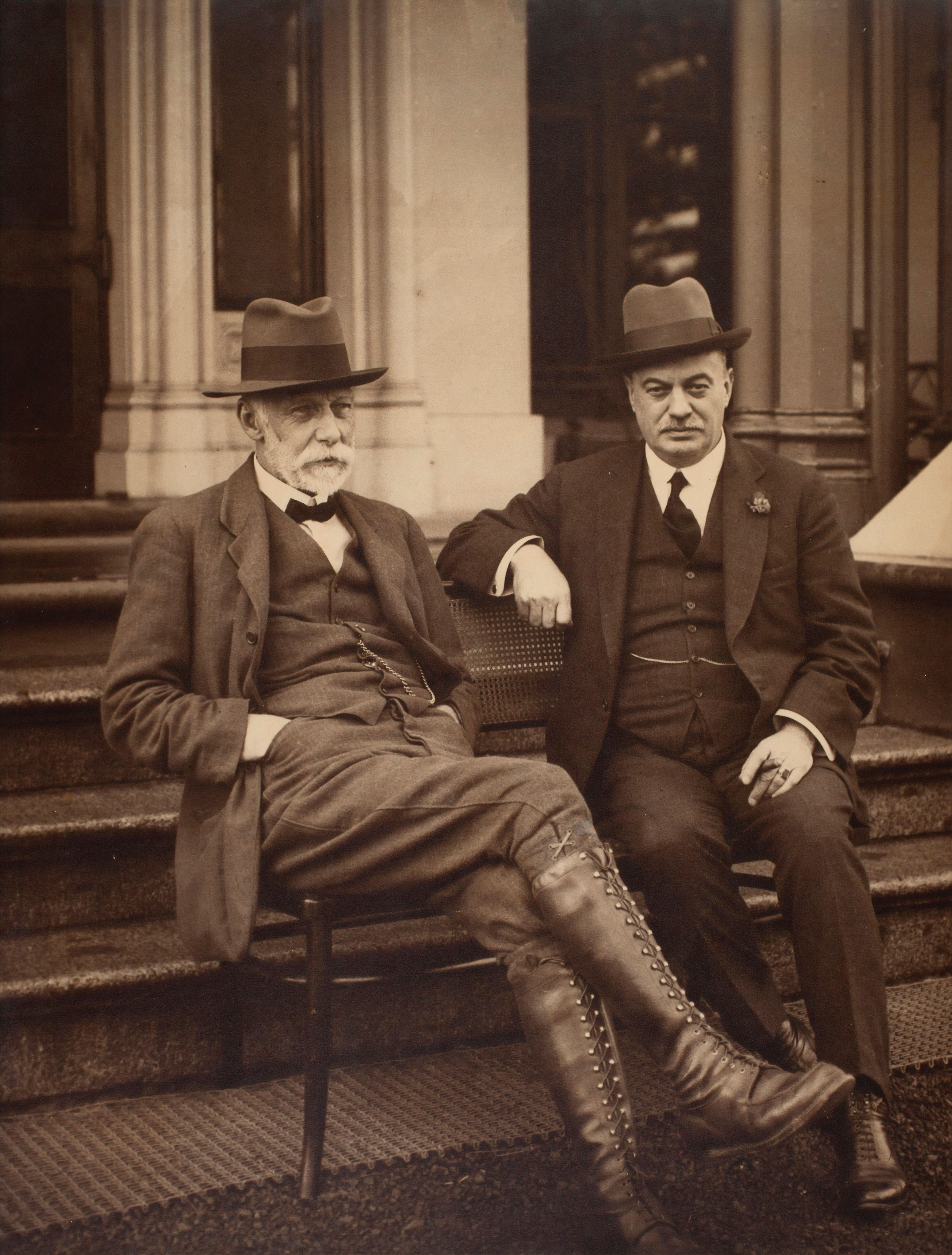Introduction
We can’t be sure that men of the future will have lower testosterone levels than they do today, but studies have revealed a “slow and consistent decline” over several past decades. While researchers have called this trend “alarming” from an evolutionary standpoint, history does paint a picture of a continual rise and fall in historical testosterone levels over the centuries based on different social and environmental shifts.
Explore our speculative timeline as we dig into the past to uncover potential factors that may have contributed to a change in male testosterone levels over time. Also find out why testosterone levels are falling again in more recent years and what you can do to keep your own T levels at a healthy level.
Key takeaways:
- Male testosterone levels are in a slow and steady decline, due to such factors as decreased physical activity, poor dietary patterns, and exposure to endocrine disrupting chemicals.
- There’s evidence that prehistoric males had more testosterone related to their physically demanding lifestyles and dietary choices.
- As the world became more modernized, with agriculture replacing foraging, and industrialization replacing agriculture, our lives became more sedentary, chemicals became more prolific, and T levels continued to drop.
- Improving your diet, exercising more, and taking medication are all different ways you can increase your own testosterone levels without reverting to the hunter-gatherer lifestyle.
Why do testosterone levels throughout history fluctuate?
From the physically demanding lifestyle of early humans to the sedentary lifestyle imposed by the Industrial Revolution, there are a number of events throughout history that likely contributed to a fluctuation in testosterone levels. View the biggest potential contributors below.
Prehistoric era
According to a 2014 study, prehistoric males had heavier brows and longer faces, indicating more circulating testosterone. These high levels didn’t just give them stronger, thicker bones, but also a more aggressive disposition. Lead author of the study, Robert L. Cieri argued that as testosterone levels decreased, as indicated in rounder skulls, males became less aggressive and more cooperative, which was helpful when living in close quarters with one another. But it does make us wonder why they had such high levels to begin with.
There are a number of hypotheses about why early humans had higher testosterone levels. For one, the physically demanding lifestyle of hunting and gathering would have likely contributed, as exercise has been shown to increase serum testosterone concentrations. But there’s also evidence that testosterone increases when hunters are successful. In a study of 31 Tsimane hunters aged 18–82 years, researchers found that testosterone increased at the time of a kill, and remained high as successful hunters returned home. Previous studies have already shown that high-stakes and success in the presence of relevant audiences results in increased neuroendocrine arousal. But this study of Tsimane hunters found that the most notable contributor to the testosterone spike was not “showing off” to fellow hunters, but providing for their families.
A successful hunt would have also contributed to meat in the prehistoric male’s diet, which is just one important component to a diverse ancestral diet. Of course, not every hunt was a success, and this helped too. High protein diets have actually been associated with lower testosterone, which is why the variation found in prehistoric diets was crucial to maintaining high T levels. According to this study on the ancestral human diet, early humans obtained about 35% of their dietary energy from fats, 35% from carbohydrates, and 30% from protein. Saturated fats contributed approximately 7.5% total energy and harmful trans-fatty acids, which constitute some of the worst foods for testosterone, contributed negligible amounts. Ancient diets were high in polyunsaturated fat (healthy fats), fruits, and vegetables, and consumption of grains and dairy was low, another pattern found to be supportive of healthy T levels.
Agricultural Revolution
The transition from the nomadic lifestyle of hunting and gathering to a more settled existence during the Agricultural Revolution would have resulted in a slight decline in testosterone levels. However, even though humans didn’t roam as frequently, they were still physically active as they tended to the land. In fact, a review of energy expenditure in contemporary subsistence farmers has suggested that levels of energy expenditure were moderate to high, while a study of foragers found that their energy expenditures were lower than expected despite high levels of physical activity. This is because food production generates new demands for “food processing,” meaning that farmers had to work harder to produce the same amount of dietary energy as foragers.
But there were obvious changes. Though a farmer’s diet would have consisted of mostly natural foods, there was not as much diversity. Studies show that where foragers had consumed a varied diet depending on what was available, farmers now increasingly invested in a single food web. Early farmers also tended to incorporate higher levels of carbohydrate from grains, but lower levels of fiber, micronutrients, and protein, which would have likely influenced hormonal function. Low levels of dietary protein are also associated with slower childhood growth and with higher levels of fat storage.
Industrial Revolution
You may not consider the factory work of the Industrial Revolution to be “sedentary” in comparison to the office jobs of today, but compared to the physical labor of farming, it was far less demanding. As machines replaced human exertion, an increasingly sedentary lifestyle likely contributed to a gradual decrease in testosterone levels.
But less physical labor is just one potential contributor to hormonal decline. This 2019 study suggests that during industrialization, humans were progressively and increasingly shielded from both daylight duration by indoor work, and environmental temperature by heating and air conditioning. These lifestyle changes may have resulted in a “de-seasonalization” of human reproduction and possibly in testosterone fluctuation. This may be related to a lack of vitamin D, as low testosterone has been associated with vitamin D deficiency.
Factory work also resulted in an increased exposure to toxic chemicals, such as lead. Lead poisoning is one of the earliest identified and most known occupational diseases. Studies show lead exposure may alter male sex hormones, thus impeding endocrine function and Sertoli cells. The CDC also reports that lead interferes with a hormonal form of vitamin D which negatively impacts multiple processes in the body, including cell maturation and skeletal growth.
There was one benefit though. Although farmers had been eating more natural foods, research indicates that men working in factories made more money and had easier access to a wider variety of foods, including more protein, which would have helped their testosterone from a dietary standpoint.
Late 20th century
What the Industrial Revolution started had intensified by the late 20th century. Testosterone levels continued to decline due to increased exposure to environmental toxins, which were now in plastics, cleaning products, cosmetics, and even in water. Though endocrinologist Roy Hertz stated in 1958 that certain synthetic hormones used in farming could end up in our bodies and mimic endogenous hormones, no action was taken until the 1970s, when physicians and researchers began to link certain chemicals with rare cancers and reproductive effects in humans and wildlife. But as our awareness increased, so did the amount of endocrine disruptors in the environment.
Dietary habits and an increasingly sedentary lifestyle also contributed to lower T levels. This study conducted in Boston, Massachusetts noted a substantial, age-independent population-level decrease in testosterone levels, potentially attributable to “birth cohort differences or to health or environmental effects.” Rising rates of obesity compounded by poor diet and less exercise all played a role. One study found that a four-inch increase in waist size increased a man's odds of having low testosterone by 75%.
21st century
So where are we today? According to research presented at the 2020 American Urological Association Virtual Experience, testosterone levels have continued to drop from 1999 to 2016. Along with less physical activity, more endocrine disruptors in our environment, and the dangers of the modern Western diet, researchers have noted an increase in comorbidities, including diabetes, which may also be contributing to this widespread testosterone decrease. Researchers also pointed to an elevated BMI as a contributor, with the mean BMI increasing from 25.83 in 1999-2000, to 27.96 in 2015-2016 (P = 0.0006).
Another threat to consider is the rise in alcohol use among adults. Though binge drinking declined from a peak in approximately 1982 to less than 20% for both boys and girls in 2019, adult alcohol use and binge drinking has been increasing. According to the National Institute on Alcohol Abuse and Alcoholism, alcohol use affects all three parts of the hypothalamic-pituitary-gonadal (HPG) axis, a system of endocrine glands and hormones which are involved in male reproduction. Alcohol use is associated with low testosterone as well as altered levels of additional reproductive hormones.
An increase in stress is another reason why T levels may be taking a hit. According to a recent Gallup poll, four in 10 adults worldwide said they experienced a lot of worry or stress. This 2016 study found that high levels of the stress hormone cortisol actually block the effects of testosterone. And chronically elevated cortisol levels can produce impotence and loss of libido by inhibiting overall testosterone production in men.
How to treat low testosterone
Testosterone levels 1,000 years ago may have been higher than they are today, but we can turn things around. While we’re not suggesting returning to the hunter-gatherer lifestyle, there are some habits from our ancestors that can easily be adapted to modern life.
Increasing your physical activity and adjusting your diet to be more diverse are two ways you can successfully improve your testosterone and your overall health, no hunting license needed. There are also a number of supplements and medicinal options, such as enclomiphene citrate, which can help. Enclomiphene citrate is proven to stimulate your body’s natural production of testosterone, whether you have low levels to begin with or you’re simply looking to optimize your T levels for more energy, increased libido, and a better physique.
Where we are today doesn’t have to be where we are tomorrow. Learn more about how Enclomiphene and the Maximus Testosterone Protocol can work for you.
Disclaimer: The contents of this article, including, but not limited to, text, graphics, images, and other information, is for information purposes only and does not constitute medical advice. The information contained herein is not a substitute for and should never be relied upon for professional medical advice. The content is not meant to be complete or exhaustive or to be applicable to any specific individual's medical condition. You should consult a licensed healthcare professional before starting any health protocol and seek the advice of your physician or other medical professional if you have questions or concerns about a medical condition. Always talk to your doctor about the risks and benefits of any treatment. Never disregard or delay seeking professional medical advice or treatment because of something you have read on this site. Maximus does not recommend, endorse, or make any representation about the efficacy, appropriateness, or suitability of any specific test, products, procedures, treatments, services, opinions, healthcare providers or other information contained herein. Maximus is not responsible for, nor will they bear any liability for, the content provided herein or any actions or outcomes resulting from or related to its use.





